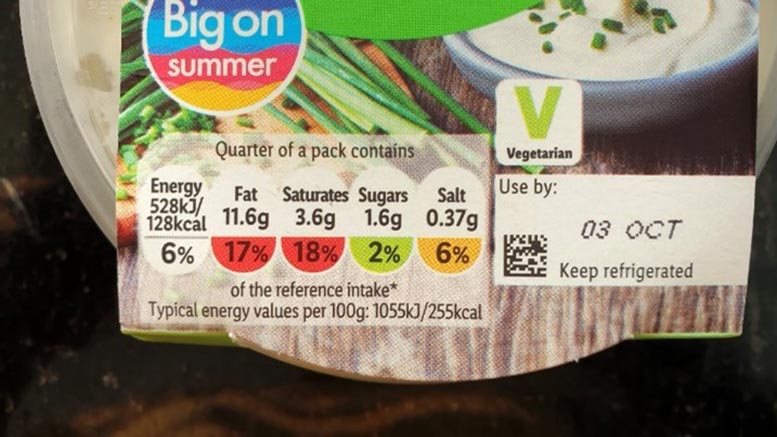
The UK Traffic Light nutrition label on pre-packaged processed foods. Credit: Sonia Pombo-Rodrigues, CC BY 4.0
New analysis of 118 studies conducted over 30 years could help refine, improve food labeling policies.
A new analysis has integrated findings from 134 studies of the impact of color-coded nutrition labels and warnings found on the front of some food packaging, indicating that these labels do indeed appear to encourage more healthful purchases. Jing Song of Queen Mary University of London, UK, and colleagues present these findings in the open-access journal PLOS Medicine.
Some countries have introduced mandatory front-of-package labeling in hope of improving people’s diets and reducing the burden of diseases associated with poor diets. These labels may employ color coding to indicate nutrition, or they may warn consumers about unhealthful features of products. However, studies on the impact of such labeling have produced mixed evidence.
To help clarify the impact of front-of-package nutrition labels, Song and colleagues analyzed data from 134 peer-reviewed studies published between January 1990 and May 2021. They applied an analytical method known as network meta-analysis in order to integrate the results of the studies and evaluate the impact of four different labeling systems—two that use color-coding and two that use warnings.
This meta-analysis showed that all four labeling systems appeared to be advantageous in encouraging consumers to purchase more nutritionally beneficial products. Evaluation of specific nutritional qualities found that labeling nudged consumers towards foods and drinks with lower levels of energy, sodium, fat, and saturated fat.
The analysis also highlighted psychological mechanisms that may underlie the different strengths of different labels, due to their impact on consumers’ understanding of nutrition information and resulting changes in attitudes towards unhealthful or healthful foods. Color-coded labels appeared to be more beneficial in promoting more healthful purchases, and warning labels were more effective in discouraging unhealthy purchases.
These findings could help guide and refine policies on front-of-package labeling to improve public health. Meanwhile, future research could build on this study by addressing related concepts, such as the impact of labeling on reformulation of products by the food industry or more long-term benefits of labeling on purchasing behavior.
“This study found that color-coded labels and warning labels are all able to direct consumers towards more healthful purchase behavior,” the researchers add. “Color-coded labels can promote the purchase of more healthful products, while warning labels discourage the purchase of less healthful products.
Reference: “Impact of color-coded and warning nutrition labelling schemes: A systematic review and network meta-analysis” by Jing Song, Mhairi K. Brown, Monique Tan, Graham A. MacGregor, Jacqui Webster, Norm R. C. Campbell, Kathy Trieu, Cliona Ni Mhurchu, Laura K. Cobb and Feng J. He, 5 October 2021, PLoS Medicine.
DOI: 10.1371/journal.pmed.1003765









Be the first to comment on "Color-Coded Nutrition Labels and Warnings Linked to Healthier Food Purchases"